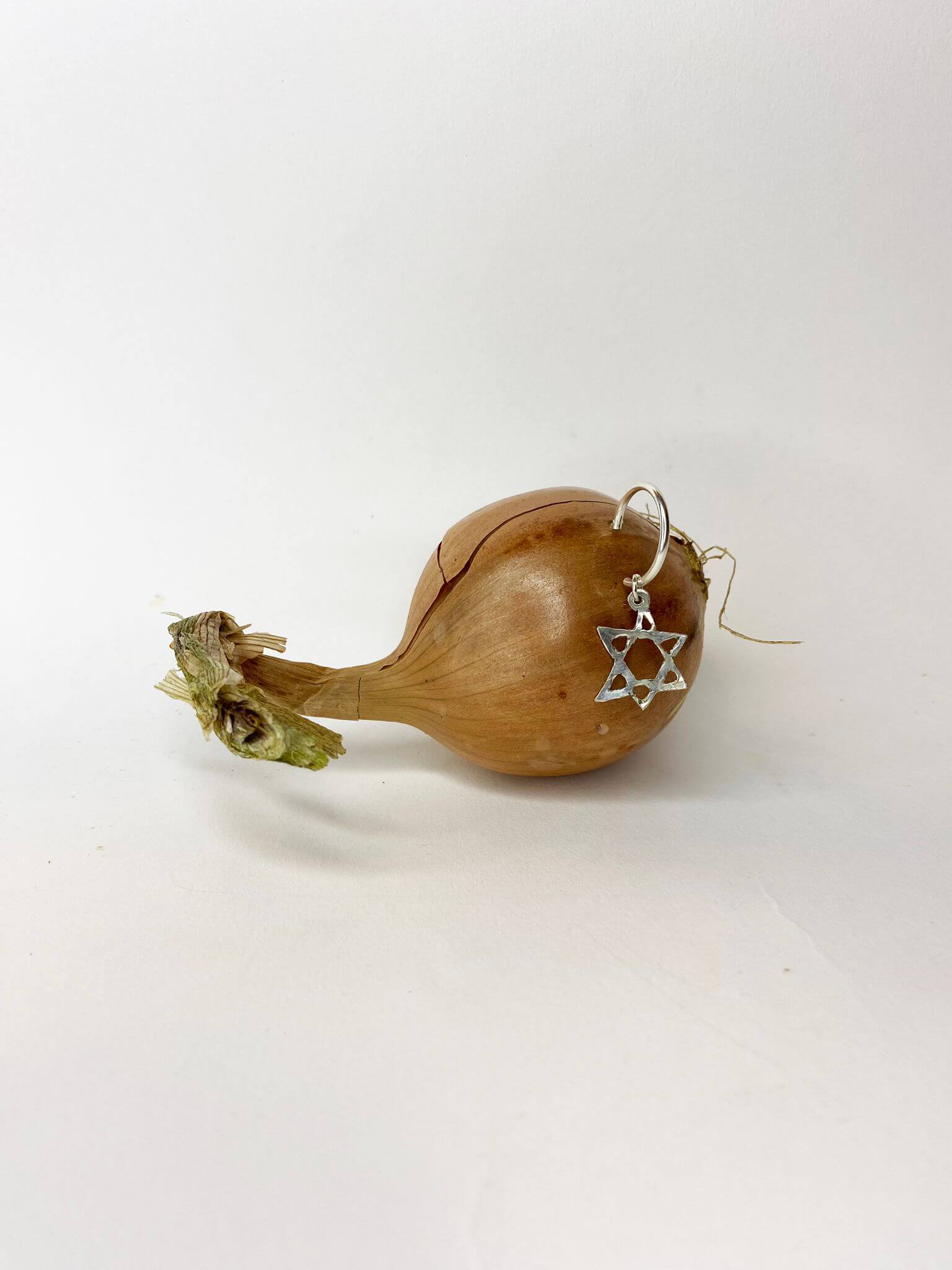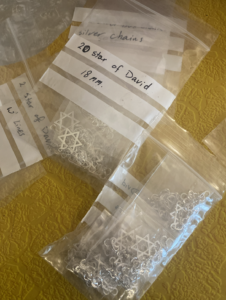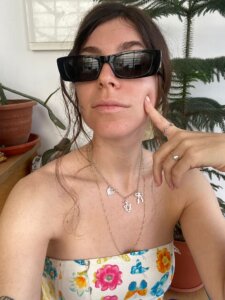Hip Israeli designers embrace Stars of David after Oct. 7
Sales of Judaica are skyrocketing around the world

Graphic by Angelie Zaslavsky
Before Oct. 7, the Israeli designer Noa Tarlovsky created what she calls “slow and colorful clothes” — funky streetwear made of upcycled fabrics under the label Ofnat Bracha. These days, she is making and selling Stars of David, using equipment that belonged to her grandmother, a Holocaust survivor and jeweler.
“I just felt, like, physically the need to wear it,” Tarlovsky said of the Jewish symbol in a recent phone interview while biking to her studio-slash-apartment in Jaffa.
The icon that the Nazis forced Jews to sew onto their clothes and then became the centerpiece of the Israeli flag is now being reclaimed by young, secular Israelis who previously considered it a province of the political or religious right wing. Anti-occupation activists, Tel Aviv hipsters and others are not only embracing but reinventing the star — called a Magen David in Hebrew — and other emblems of Judaica with a cool aesthetic.
Lior Raz, co-creator and star of the Israeli television series Fauda, posted an Instagram video of himself wearing a large gold star pendant with the message: “Wear it proud! Don’t be afraid!”

Noam Elazar, the designer behind the modern jewelry company Odd Pearls, started selling imperfect, amorphous Star of David and Chai pendants in brass or silver for $130 each via Instagram at the end of October. She said she donates 10% of the profits to the Hostages and Missing Families Forum, but would not say how much that has been so far. She said the Jewish charms had outsold her other jewelry.
“I think everyone has been wearing some sort of religious sign on themselves since October,” Elazar wrote me on WhatsApp. In Israel and around the world, she said, people “are trying to figure out how to show their pride through all the hate and fear.”
It is difficult to quantify such a cultural shift, one of many changes both in Israel and among diaspora Jews since the terror attack in which Hamas killed 1,200 people and kidnapped another 240, prompting a war in Gaza that Hamas says has taken the lives of 18,000 Palestinians. But anecdotes abound of Jews around the world unearthing old B’nei Mitzvah gifts from drawers or buying new items featuring Jewish symbols.
The California-based Jewelry Judaica said sales were up 450% between Oct. 7 and Dec. 7 compared to the same period last year, and that 85% of those sales featured Stars of David. Sales at the Jewish Museum in New York, meanwhile, have tripled.
My close friend Eve Guterman, who moved to Tel Aviv 12 years ago from New York, has been wearing an Ofnat Bracha Magen David that she bought as soon as Tarlovsky started selling them on Nov. 13 and has been wearing every day since. She’s also lit Shabbat candles every Friday since Oct. 7, making her occasional practice a consistent one. And she told me she has been reciting prayers for the hostages, Israeli soldiers and the civilians of Gaza after the one for the candles themselves. Guterman, 34, who is a graduate student at Tel Aviv University and a freelance producer for NPR, said she has yet to make it through the ritual without crying.
Danielle Thereze Bodenheimer, an Israeli fashion designer and nail artist, meanwhile, has been wearing a choker featuring a hamsa, a hand symbol that represents protection in both Jewish and Muslim traditions.
“On Oct. 7, I became Jewish,” Bodenheimer told me. Before, she said, she defined herself as an Israeli and “a citizen of the world,” and sometimes felt resentful of her Jewish identity. Now she feels very connected to it.
And she likes the hamsa because it is both a specifically Jewish symbol and a more universal one shared with her Arab neighbors.
“For me, it’s mystical, but it is connected to Judaism,” she explained. “And more than that it’s connected to living in the Middle East.”
The simple gesture of putting on a necklace has, in these fraught times, become much deeper. As I reached out to Jewish WhatsApp groups and listservs I’m part of to inquire about this trend, people told me, both via email and over the phone, long emotional and historical backstories about their Jewish identities and family histories.
They are embracing the stars, they told me, because they feel vulnerable, proud, hopeless, betrayed, bereaved. And very, very Jewish.
Brit Fleck, who is studying for a master’s degree in public health at Yale University, ordered a Star of David pendant from Etsy on Oct. 8. She said she is not sure why — and that she has yet to put it on, afraid of people on campus being able to identify her as a Jew or making assumptions about her politics.
“This is so nuanced and complicated,” she wrote me, adding that she has not worn the necklace because she does not want “the additional labor of needing to ‘explain’ the nuance of it all,” nuance she’s still sorting out herself.
Over Thanksgiving, she found a Magen David saved by her great-grandmother, who came to the United States from Hungary. It felt significant that an ancestor had saved it, and Fleck felt even more pulled to the symbol — yet she remained hesitant about actually wearing it.
Sarah Chandler, who lives in Brooklyn and teaches Jewish mindfulness and spirituality, found a complex way to express her feelings about the situation. For the week after Oct. 7, she avoided jewelry altogether to embrace the mindset of a mourner during shiva. Then she reached out to a Palestinian Muslim she met in 2015 who runs a shop in Jerusalem’s Old City, where tourism has all but disappeared since the war.

Chandler said she ordered more than $1,000 worth of Magen David necklaces from this shop owner and gave them to friends and family. Before Oct. 7, Chandler said, wearing the star felt “tacky” or “Holocausty.” But now, it is “a reminder to pray and sing in Hebrew,” which nourishes her soul, she said. And seeing other Jews visibly identified as Jewish in public makes her feel “5% calmer.”
Back in Israel, Tarlovsky’s Star of David hangs on a silver chain between two other charms: a heart and a bow, reminiscent of the yellow ribbons representing the hostages.
But the company’s most popular new piece is a single hoop earring with a dangling Star of David. On her website, the jewelry appeals to a youthful clientele by playfully hanging off of raw fruit and vegetables: The earring sticks out of a raw onion; the charm necklace lies atop an orange. They’re all silver and made by hand, with prices ranging from around $50 to $200.
She said she sold 30 in the first three weeks.
Tarlovsky opened Ofnat Bracha in 2020 and runs it out of her home in Jaffa. She named the brand after a boutique in Holon opened by her grandparents; she grew up hearing stories of how her grandfather survived Auschwitz-Birkenau by working as the death camp’s tailor.
Tarlovsky spent the weeks at the start of the war sewing clothes for soldiers — she wasn’t told exactly what she was making for whom, but it involved camouflage.
Like many in Israel, Tarlovsky is wracked with survivors’ guilt. Her brother’s best friend, Omri Belkin, was a reservist in a counterterrorism unit and was killed responding to the Hamas attack at Kibbutz Be’eri. She now feels abandoned both by Israel’s extreme right-wing government and by the global left she used to see as allies.
“We get so much hate from around the world and truly understand we only have each other,” she said of Israelis. “It’s actually quite interesting how everyone now feels the need to wear a Magen David necklace. I mean even hipster girls in Tel Aviv are wearing one. After Oct. 7 our lives changed forever.”















